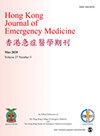E-learning and virtual patient simulation in emergency medicine: New solutions for old problems
IF 0.8
4区 医学
Q4 EMERGENCY MEDICINE
引用次数: 1
Abstract
Creative Commons Non Commercial CC BY-NC: This article is distributed under the terms of the Creative Commons Attribution-NonCommercial 4.0 License (http://www.creativecommons.org/licenses/by-nc/4.0/) which permits non-commercial use, reproduction and distribution of the work without further permission provided the original work is attributed as specified on the SAGE and Open Access pages (https://us.sagepub.com/en-us/nam/open-access-at-sage). In this issue of HKJEM, Chen et al. examined the effectiveness of paediatric emergency medicine education in a nationwide survey involving 258 emergency residents and physicians in 43 teaching hospitals in Taiwan. Notably, the study reported a lack of confidence in paediatric resuscitation. Only 52.3% of the respondents felt confident enough to care for the acute paediatric resuscitation, possibly due to lack of exposure to paediatric critical patients. Also, more than half of the respondents felt their paediatric emergency case exposure was insufficient and would like more extended paediatric emergency training.1 That resonates with similar findings in other parts of the world, where a perception of a lack of paediatric case exposure was found among emergency medicine trainees.2,3 Perceptions of inadequacy of case exposure in other specialties like geriatrics, psychiatry and obstetrics were also reported.4–6 The cause could be multifaceted, including a deficiency in rotation opportunity, a lack of clear training objectives and structured experience in curriculum, and low caseload in some geographical regions. This situation is problematic as it has the potential to affect the quality of care and even the safety of certain groups of emergency department patients. Due to logistic reasons and time limitations, emergency medicine education administrators often cannot arrange for trainees to rotate to all the other specialties. For example, the current training curriculum of the Hong Kong College of Emergency Medicine7 does not require a compulsory rotation to paediatrics, geriatrics, psychiatry or obstetrics. In this regard, the exposure of a trainee in a particular patient group would be highly dependent on the case-load profile of the hospital he or she is being trained in. Worse still, the COVID-19 pandemic has aggravated this problem due to decrease patient volume and cancellation of training activities.8,9 To compensate for the inadequacy in training time in other specialties, one of the solutions would be enhancing emergency medicine training by ‘e-learning’. ‘E-learning’ or ‘electronic learning’ is often considered synonymously with ‘online learning’. This interpretation is overly simplistic. Pachler et al.10 defined e-Learning as ‘learning facilitated and supported through the use of information and communications technology, which may involve the use of computers, educational software, interactive whiteboards, digital camera, mobile devices, video-conferencing, virtual learning environment and online learning management system’. By moving teaching and learning online, well-designed e-Learning programmes break the limitation of rotation arrangement. e-Learning fits with the learning theory of student-centred learning and the flipped classroom which were shown to be superior to the traditional, didactic model of teaching.11,12 Programmes can ensure content coverage and allow trainees to learn at their own pace whenever and wherever they want. A meta-analysis by Cook et al. summarised a significant positive learning effect of e-learning compared with no intervention in health professions students regarding knowledge outcome, skills, learner behaviour and patient effect. However, the heterogenicity of difference studies was large.13 A crucial question remains: What characteristics make an e-learning programme effective? In this issue of HKJEM, Tyebally and Dong report a qualitative focus group study of 27 residents from family medicine, emergency medicine and paediatric medicine. Theme analysis showed that crucial elements for the success of an e-learning programme would include access (e.g. early and unlimited access and easy technical access), instructional method (e.g. casebased scenario, interactive quiz, feedback and multimedia), design (e.g. purposeful organisation, autonomous learning and appropriate volume) and supplementary learning (e.g. synergism with team-based learning, written material and guidelines).14 Another possible activity to address a lack of clinical exposure would be simulation training. Simulation provides standardised, repeatable scenarios for students without the availability of actual patients. It is already used in emergency medicine education and has been shown to have a favourable training effect on knowledge and clinical competence.15 The benefits of simulation training include patient safety, psychological safety for trainees, repeatability, and availability of feedback. However, simulation training may be limited by its cost and availability. High-fidelity manikins and simulation training centres are often very E-learning and virtual patient simulation in emergency medicine: New solutions for old problems 1124754 HKJ0010.1177/10249079221124754Hong Kong Journal of Emergency MedicineLaw and Kelly editorial 2022急诊医学中的电子学习和虚拟病人模拟:老问题的新解决方案
知识共享非商业性CC BY-NC:本文在知识共享署名-非商业4.0许可(http://www.creativecommons.org/licenses/by-nc/4.0/)的条款下发布,该许可允许非商业用途,复制和分发作品,无需进一步许可,前提是原始作品的署名与SAGE和开放获取页面(https://us.sagepub.com/en-us/nam/open-access-at-sage)上指定的一致。在这一期的《香港医学杂志》上,Chen等人对台湾43家教学医院的258名急诊住院医师和医生进行了一项全国性调查,研究了儿科急诊医学教育的有效性。值得注意的是,该研究报告了对儿科复苏缺乏信心。只有52.3%的受访者有足够的信心照顾急性儿科复苏,可能是由于缺乏对儿科危重患者的接触。此外,半数以上的答复者认为他们对儿科急诊病例的了解不足,希望得到更广泛的儿科急诊培训这与世界其他地区的类似发现产生了共鸣,在那里发现急诊医学学员缺乏儿科病例接触的感觉。2,3在其他专业,如老年病学,精神病学和产科的病例暴露不足的看法也有报道。4-6原因可能是多方面的,包括轮岗机会不足,缺乏明确的培训目标和结构化的课程经验,以及一些地理区域的病例量低。这种情况是有问题的,因为它有可能影响护理质量,甚至影响某些急诊科患者的安全。由于后勤原因和时间限制,急诊医学教育管理人员往往不能安排学员轮转到所有其他专业。例如,香港急救医学院目前的培训课程7并不要求强制转到儿科、老年病学、精神病学或产科。在这方面,受训者在特定病人群体中的接触程度将高度取决于他或她正在接受培训的医院的病例负荷情况。更糟糕的是,新冠肺炎疫情导致患者数量减少,培训活动取消,使这一问题更加严重。8,9为了弥补其他专业培训时间的不足,解决办法之一是通过"电子学习"加强急诊医学培训。“E-learning”或“电子学习”通常被认为是“在线学习”的同义词。这种解释过于简单化。Pachler等人10将电子学习定义为“通过使用信息和通信技术促进和支持学习,这可能涉及使用计算机、教育软件、交互式白板、数码相机、移动设备、视频会议、虚拟学习环境和在线学习管理系统”。通过将教学和学习转移到网上,精心设计的电子学习项目打破了轮岗安排的限制。电子学习符合以学生为中心的学习理论和翻转课堂,翻转课堂被证明优于传统的说教式教学模式。11,12方案可以确保内容覆盖,并允许受训者随时随地按照自己的节奏学习。Cook等人的一项荟萃分析总结了电子学习在卫生专业学生的知识成果、技能、学习者行为和患者效果方面与不干预相比具有显著的积极学习效果。然而,差异研究的异质性较大一个关键的问题仍然存在:什么特征使电子学习计划有效?在这期《香港医学杂志》上,Tyebally和Dong报告了一项定性焦点小组研究,涉及27名来自家庭医学、急诊医学和儿科医学的住院医生。主题分析表明,电子学习方案成功的关键要素包括获取(如早期和无限制的获取以及简单的技术获取)、教学方法(如基于案例的场景、互动测验、反馈和多媒体)、设计(如有目的的组织、自主学习和适当的数量)和补充学习(如与基于团队的学习、书面材料和指导方针的协同作用)另一个可能解决缺乏临床接触的活动是模拟训练。模拟为学生提供标准化的、可重复的场景,而没有实际患者的可用性。它已被用于急诊医学教育,并已被证明对知识和临床能力有良好的培训效果模拟训练的好处包括患者安全、受训者的心理安全、可重复性和反馈的可用性。 然而,模拟训练可能受到其成本和可用性的限制。高保真人体模型和模拟培训中心通常在急诊医学中非常电子学习和虚拟患者模拟:老问题的新解决方案[124754]hkj0010.1177 /10249079221124754香港急诊医学杂志法律和凯利编辑2022
本文章由计算机程序翻译,如有差异,请以英文原文为准。
求助全文
约1分钟内获得全文
求助全文
来源期刊

Hong Kong Journal of Emergency Medicine
EMERGENCY MEDICINE-
CiteScore
1.50
自引率
16.70%
发文量
26
审稿时长
6-12 weeks
期刊介绍:
The Hong Kong Journal of Emergency Medicine is a peer-reviewed, open access journal which focusses on all aspects of clinical practice and emergency medicine research in the hospital and pre-hospital setting.
 求助内容:
求助内容: 应助结果提醒方式:
应助结果提醒方式:


